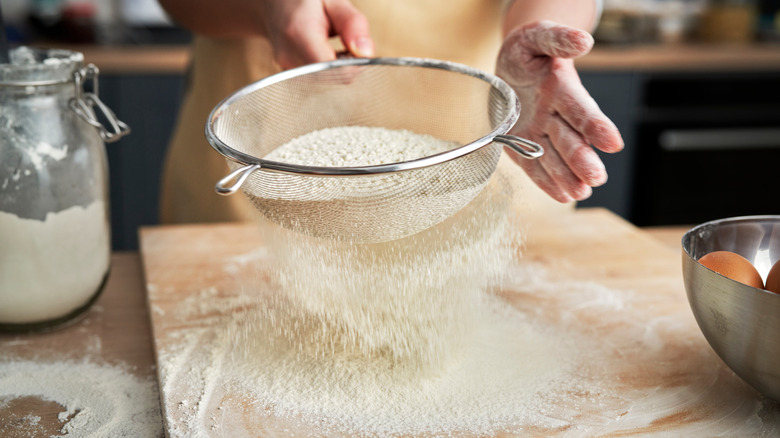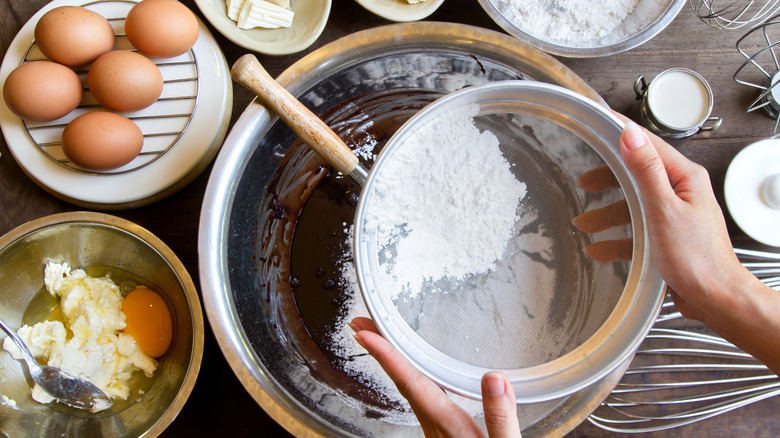The Tedious Step Duff Goldman Never Skips While Baking
When perusing the ingredients in a cake recipe, you might squint at the "sifted" part written next to the flour, and consider skipping that step — how much of a difference can it make? If you ask Duff Goldman, the answer is a big one. Speaking to Allrecipes, the celebrity baker and "Ace of Cakes" star admitted that he, too, was once guilty of skipping out on sifting, and doubted its necessity. "This feels like something leftover from a bygone era when flour was clumpier," he said of his skepticism. After all, the task can give you hand cramps if you use an old-fashioned sifter, and many bakers today aren't clear on why flour needs to be sifted at all.
Goldman's enlightenment came when his Food Network colleague, Nancy Fuller, convinced him to sift the dry ingredients in a cake recipe he struggled with. If your cakes never turn out as light and fluffy as they should, sifting could change your entire view, too. This prep step breaks up clumps or clusters in dry ingredients and turns them into light, fine powders. This helps you measure flour more accurately and ensures that your cake takes on the texture it's meant to have. Goldman's only regret about sifting is not trying it sooner. "I just think of how many cakes I've made in my life and how many of them could have been better if I just sifted my flour," he stated.
Why sifting makes such a difference in baking
Neglecting to sift is a mistake that virtually everyone makes when baking a cake. Baking depends on accurate measurements, and clumps in flour, sugar, or other dry goods can increase ingredient quantities and throw off your recipe. Besides ensuring accurate measurements, sifting creates a better texture in cakes, cookies, and other treats. This step tosses around dry ingredients until each tiny grain is separated. It also aerates and lightens flour, making it easier to whisk into other ingredients. When you add fat like milk or butter to your dry ingredients, it will coat each grain thoroughly, resulting in evenly-blended, well-hydrated batters or doughs that make moist, tender, and fluffy baked goods.
Even if you know how important sifting is, you might skip doing it yourself, because many commercial flours come pre-sifted. In some cases, you can skip sifting by hand, such as for cookies, muffins, breads, and dense cakes made with butter. However, there are times when you must sift your flour, no matter what. If the only thing stopping you is a lack of a dedicated flour sifter, passing dry powders through fine-mesh strainers, sieves, or even colanders will do.
You can also use a fork or whisk to quickly fluff up dry goods, though this will only serve to break up lumps. This can be fine for denser baked goods, but for a light sponge cake with berries or ultimate chocolate cake, you better sift more thoroughly.
When you shouldn't skip sifting your flour
If your recipe doesn't call for sifting, but you suspect it should be done anyway, think about what you're making. Sifting is an essential step in any baked good that relies on the light airiness of the flour; uses egg whites or another rising agent for a tall structure; or requires a gentle hand when combining ingredients to avoid overmixing and toughening the batter (think of angel food and chiffon cakes).
Also, take into account the lumpiness of your flour. Fine types such as cake flour have the tendency to get more clumpy, so they should be sifted first. Sifting is also a crucial step if your flour is old and packed tightly into a container (double check that your flour hasn't expired before using it). If you're kneading bread or pie dough, and need a surface dusted with flour to prevent sticking, sift the flour, too. This creates the most fine, anti-stick surface.
You should also pay attention to where sifting is mentioned in your recipe. When a recipe asks for "sifted flour" in the ingredients list, you should sift your flour before you measure it out. On the flip side, if it says "flour, sifted," you should measure out the flour and then sift what you've scooped out. This tiny detail can make all the difference — you could end up with too much or too little flour in your recipe, otherwise.



